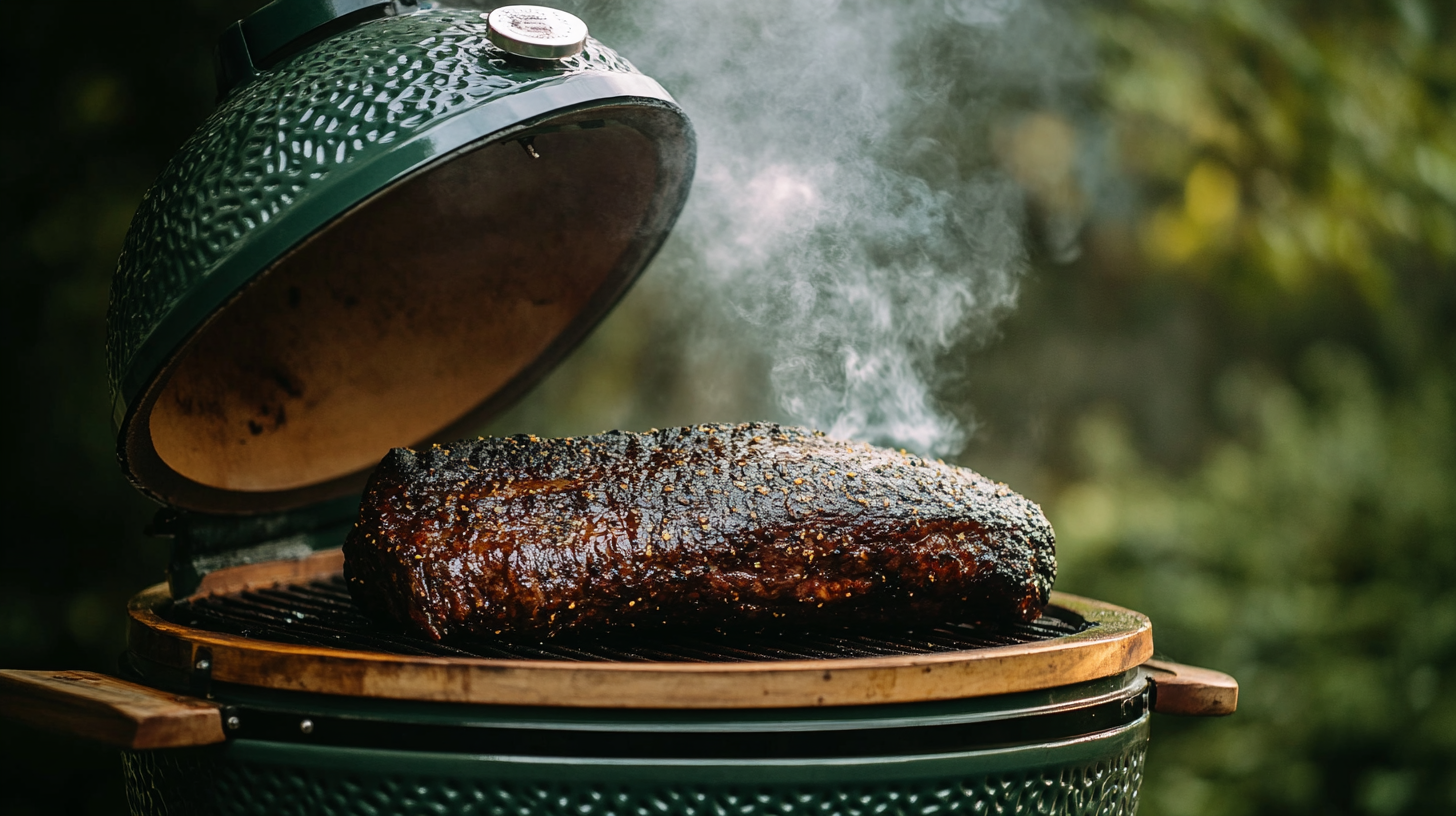A Green Egg Beef Brisket Recipe is the key to making a tender, smoky, and flavorful brisket right in your backyard. The Big Green Egg is one of the best tools for low-and-slow barbecue, allowing you to create a perfect bark, deep smoke ring, and juicy interior.
Brisket is one of the most beloved meats in barbecue, but it can be tricky to master. With the right techniques, seasonings, and temperature control, you can transform a tough cut of beef into a melt-in-your-mouth masterpiece.
In this guide, we’ll cover everything you need to know, including:
✅ How to choose the right brisket
✅ The best rubs and seasonings
✅ How to set up your Big Green Egg for perfect smoking
✅ A step-by-step cooking method for juicy, flavorful brisket
✅ Tips for handling the stall, wrapping, and slicing
By following this Green Egg Beef Brisket Recipe, you’ll learn the exact process to achieve restaurant-quality barbecue at home. Let’s get started!
Table of Contents
Understanding Beef Brisket
Before we fire up the Green Egg, let’s break down what brisket is and why it’s a BBQ favorite.
What is Beef Brisket?
Brisket comes from the lower chest of the cow, a hardworking muscle that contains a lot of connective tissue and collagen. When cooked low and slow, this tough cut transforms into juicy, fall-apart tender meat.
Flat vs. Point: The Two Parts of Brisket
A whole brisket (also called a packer brisket) is made up of two main muscles:
- Flat (First Cut) – Leaner, more uniform in shape, great for slicing
- Point (Second Cut) – More marbled, juicier, excellent for burnt ends
For beginners, a whole packer brisket is recommended, as it gives you the best balance of moisture and texture.
Why Use the Big Green Egg for Brisket?
The Big Green Egg is one of the best grills for brisket because of its insulated ceramic walls, precise temperature control, and superior moisture retention.
✅ Even Heat Distribution – The ceramic construction ensures consistent, even heat.
✅ Moisture Retention – The closed design helps keep the brisket juicy.
✅ Efficient Charcoal Use – Uses lump charcoal, which burns hotter and cleaner.
✅ Flavor Enhancement – Absorbs wood smoke flavors beautifully.
With proper setup, the Big Green Egg creates the perfect environment for a low and slow cook, which is essential for a tender, smoky brisket.
Choosing the Right Brisket
Selecting the right brisket is crucial for achieving the best results. Not all briskets are created equal, and knowing what to look for can make a significant difference in the final outcome.
Brisket Grades: Prime vs. Choice vs. Select
The USDA categorizes beef into different grades based on marbling, tenderness, and overall quality. The three main grades you’ll find in stores are:
- Prime Brisket – Highest quality with the most marbling, resulting in a juicier and more flavorful brisket. Recommended for the best results.
- Choice Brisket – Good marbling but slightly leaner than Prime. A great option if Prime is unavailable.
- Select Brisket – Least marbling, tends to be drier and requires extra care to keep it moist.
If possible, choose a Prime or high-end Choice brisket for optimal tenderness and flavor.
How to Pick the Best Brisket
When selecting a brisket, keep the following factors in mind:
- Weight – A whole packer brisket usually weighs between 10 to 16 pounds. A 12 to 14-pound brisket is ideal for most Green Egg setups.
- Flexibility – A good brisket should feel somewhat flexible when you pick it up. This indicates a good amount of intramuscular fat.
- Fat Cap – Look for a brisket with a moderate fat cap (about ¼ inch thick). Too much fat can block smoke penetration, while too little may result in a dry brisket.
By choosing the right cut, you set yourself up for success before even lighting the grill.
Essential Tools for This Green Egg Beef Brisket Recipe
Smoking brisket requires more than just a grill. Having the right tools will help ensure a smooth and consistent cooking process.
Must-Have Equipment for Smoking Brisket
- Big Green Egg (Large or XL size recommended) – Allows for sufficient airflow and space.
- Lump Charcoal – Natural hardwood lump charcoal provides steady heat without excessive ash buildup.
- Wood Chunks or Chips – Enhances smoke flavor. Hickory, oak, and pecan are great choices.
- Meat Thermometer – A high-quality digital thermometer is essential for monitoring internal temperatures.
- Drip Pan – Placed under the brisket to catch drippings and prevent flare-ups.
- Heat Deflector (ConvEGGtor) – Used to create an indirect cooking setup, ensuring even heat distribution.
- Spray Bottle – Filled with apple juice, apple cider vinegar, or beef broth to keep the brisket moist.
- Butcher Paper or Aluminum Foil – Used for wrapping the brisket during the cooking process.
Having these tools ready before you start will make the entire smoking process much easier and more efficient.
Best Wood for Smoking Brisket
Wood selection is just as important as the meat itself. The type of wood you use will impact the flavor profile of the brisket.
Recommended Wood Types for Brisket
- Hickory – Strong, bold smoke flavor. A classic choice for brisket.
- Oak – Milder than hickory, but still provides a rich, smoky flavor.
- Mesquite – Very strong and earthy. Best used sparingly or mixed with milder woods.
- Pecan – Slightly sweet with a nutty aroma. Works well in combination with oak or hickory.
- Fruitwoods (Apple, Cherry, or Peach) – Adds a touch of sweetness and pairs well with heavier woods.
For a balanced flavor, a mix of hickory and oak is recommended. If you prefer a sweeter finish, consider adding a small amount of pecan or fruitwood.
Prepping the Brisket
Properly preparing the brisket before it goes on the smoker is a critical step in achieving the best results. This includes trimming excess fat, applying a flavorful rub, and allowing the meat to absorb the seasonings.
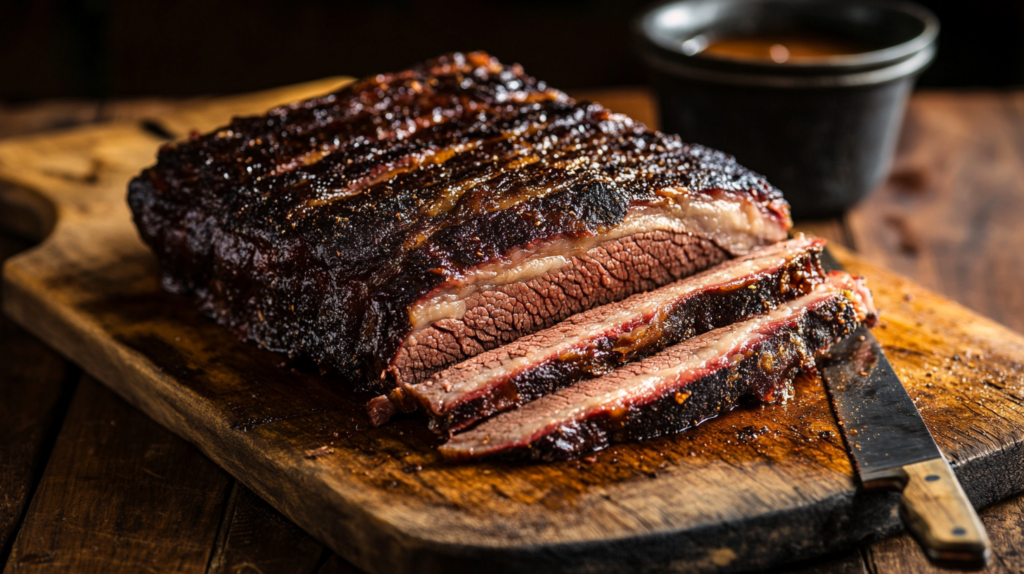
Trimming the Brisket
Briskets often come with a thick fat cap and uneven edges. While fat helps keep the meat moist, too much of it can prevent the smoke from penetrating the meat.
How to Trim a Brisket
- Remove Excess Fat – Leave about ¼ inch of fat on the top to retain moisture while allowing the smoke to penetrate.
- Trim Silver Skin – The thin, shiny membrane on the underside should be removed to help the seasoning adhere.
- Shape the Brisket – Trim off any thin edges that may burn during cooking.
- Round Off Sharp Corners – This prevents edges from drying out too quickly.
Trimming properly ensures even cooking and better flavor absorption.
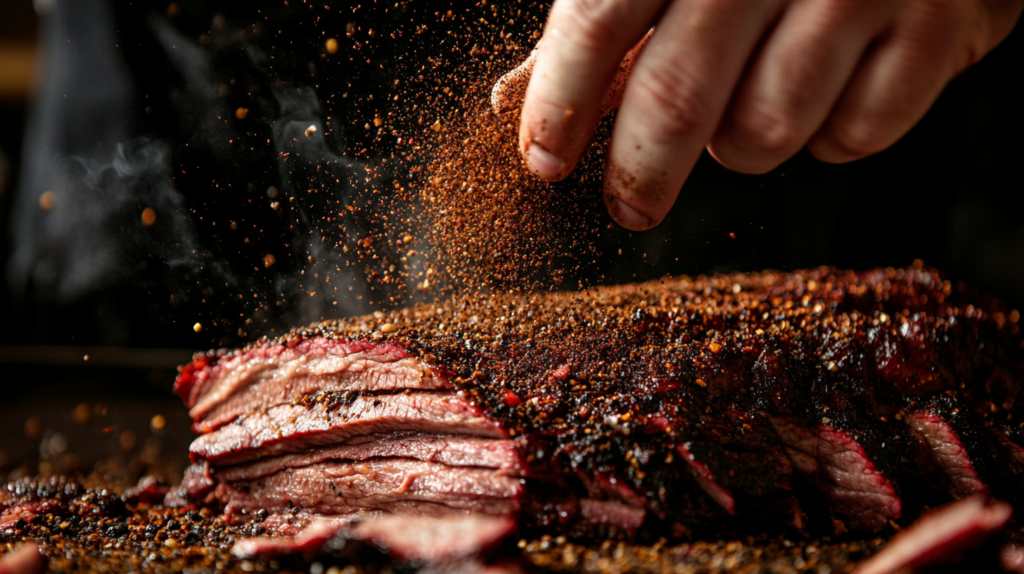
Seasoning the Brisket
A well-seasoned brisket enhances the natural beefy flavors while adding depth and complexity.
Classic Texas-Style Brisket Rub
- ¼ cup coarse kosher salt
- ¼ cup coarse black pepper
- 1 tablespoon garlic powder
- 1 tablespoon onion powder
- 1 teaspoon paprika (optional for color)
For those looking to enhance their brisket flavor, using a brine can make a big difference. Check out The Ultimate Guide to Beef Brisket Brine to learn how brining can improve tenderness and taste.
How to Apply the Rub
- Apply a Binder – Lightly coat the brisket with mustard or olive oil to help the seasoning stick.
- Season Evenly – Apply the rub generously on all sides, pressing it into the meat.
- Let It Rest – Allow the brisket to sit at room temperature for 30-60 minutes before cooking to let the seasoning absorb.
For deeper flavor, you can season the brisket and refrigerate it overnight.
Setting Up the Big Green Egg
Setting up your Big Green Egg correctly is key to maintaining a steady temperature and achieving perfect brisket.
1. Using the Right Charcoal
Always use 100% natural lump charcoal for a cleaner burn and better heat control. Avoid briquettes as they produce excessive ash that can clog airflow.
2. Adding Wood for Smoke
Place 3-5 chunks of your chosen smoking wood (hickory, oak, or pecan) throughout the charcoal. This allows the wood to burn slowly, infusing the brisket with a consistent smoky flavor.
3. Setting Up for Indirect Cooking
Use the ConvEGGtor (plate setter) to create an indirect cooking environment. This prevents direct heat from hitting the brisket and ensures an even cook.
- Place the ConvEGGtor with the legs facing up.
- Set a drip pan on top to catch rendered fat.
- Insert the grill grate above the ConvEGGtor.
4. Stabilizing the Temperature
Light the charcoal and bring the Egg to 225-250°F. This is the ideal low-and-slow temperature for brisket.
- Adjust the bottom vent for airflow control.
- Use the top daisy wheel to fine-tune the temperature.
- Allow the temperature to stabilize for at least 30 minutes before placing the brisket on the grill.
Smoking Process & Cooking Times
Now that the Egg is set up and the brisket is seasoned, it’s time for the smoking process.
1. Placing the Brisket on the Grill
- Position the fat cap up so the fat can render down and baste the meat.
- Place the brisket in the center of the grill, away from direct heat.
- Insert a meat thermometer into the thickest part of the brisket to monitor internal temperature.
2. Cooking Temperature and Time Guide
Brisket should be cooked low and slow to break down connective tissues and develop a deep smoke ring.
- Target Smoker Temp: 225-250°F
- Time Estimate: 1 to 1.5 hours per pound
- Target Internal Temp Before Wrapping: 165°F
- Final Target Internal Temp: 200-205°F
3. The Stall: What It Is and How to Handle It
At around 150-165°F, the brisket will hit a phase called the stall, where the temperature stops rising for several hours. This happens because moisture is evaporating from the meat, cooling it down.
If you’re looking for more ways to cook beef, try these Easy Beef Recipes for quick and delicious meals beyond brisket.
How to Push Through the Stall
- Be Patient – The stall is normal and will pass with time.
- Use the Texas Crutch – Wrap the brisket in butcher paper or foil at 165°F to speed up the cooking process and retain moisture.
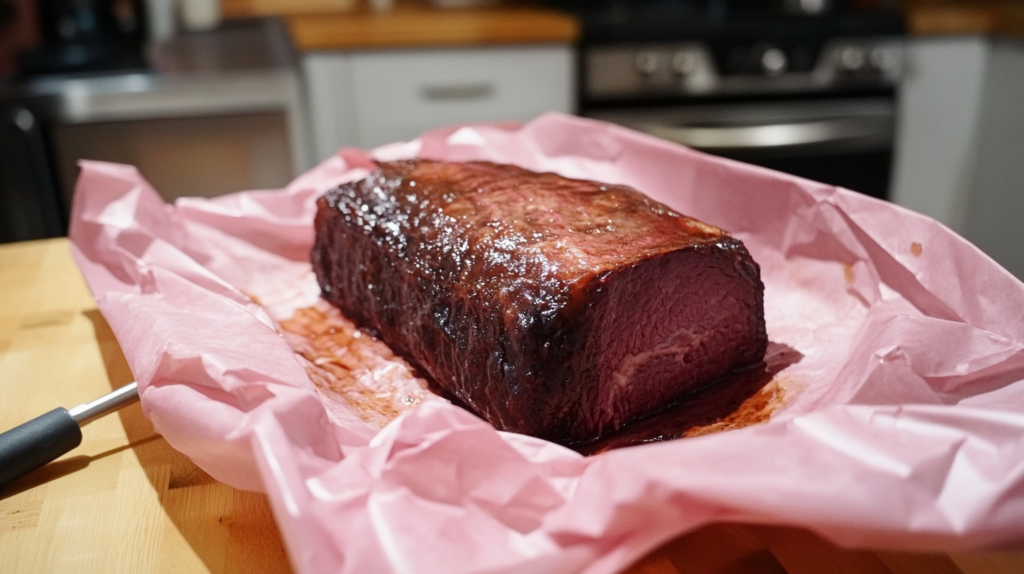
Texas Crutch: Wrapping the Brisket
Once the brisket reaches around 165°F, wrapping it can help retain moisture, reduce cooking time, and push through the stall. This method, known as the Texas Crutch, is a popular technique among pitmasters.
Foil vs. Butcher Paper: Which One to Use?
- Aluminum Foil – Seals in all moisture, making the brisket extra tender but slightly reducing bark crispiness.
- Butcher Paper – Allows some steam to escape, preserving a firmer bark while still preventing excessive moisture loss.
How to Wrap the Brisket Properly
- Lay out two sheets of foil or butcher paper, ensuring they are large enough to wrap the brisket completely.
- Place the brisket in the center and fold the edges tightly around it.
- Return it to the grill with the seam side down to keep the wrap secure.
Once wrapped, continue cooking until the internal temperature reaches 200-205°F.
When is Brisket Done?
Brisket is fully cooked when it reaches the right internal temperature and tenderness level.
Temperature Guide for Doneness
- 195°F-200°F – The brisket is nearly done but may still be a bit firm.
- 200°F-205°F – Perfect range for optimal tenderness.
- Above 205°F – Risk of overcooking, which can dry out the brisket.
The Probe Test
Instead of relying solely on temperature, use a probe test to check for doneness. Insert a thermometer probe or skewer into the thickest part of the brisket—if it slides in like butter, the brisket is ready.
Once done, remove the brisket from the grill and move on to the most important step—resting the meat.
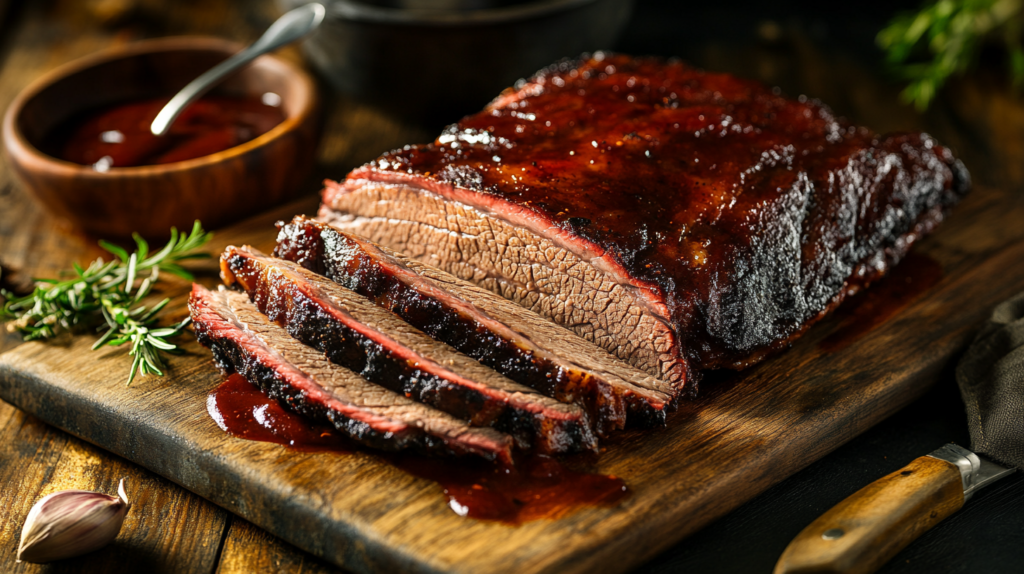
Resting and Slicing the Brisket
Why Resting is Crucial
Resting allows the juices to redistribute throughout the meat, preventing them from running out when slicing. Skipping this step can lead to dry brisket.
How to Rest the Brisket
- Wrap it in butcher paper or foil to retain heat.
- Place it in a cooler or insulated box for at least 1-2 hours.
- Let it cool to around 160°F before slicing.
How to Slice Brisket for Maximum Tenderness
- Cut against the grain to shorten muscle fibers and make each bite more tender.
- Separate the flat and point—the flat is best for slicing, while the point is great for burnt ends.
- Use a long, sharp slicing knife for clean cuts.
Proper slicing can make the difference between a tough bite and a melt-in-your-mouth experience.
Common Brisket Mistakes & How to Fix Them
Even experienced pitmasters encounter challenges when smoking brisket. Here’s how to troubleshoot common problems.
1. Brisket is Too Dry
- Cause: Overcooking or not enough fat.
- Fix: Wrap earlier, spritz with broth, and let it rest longer.
2. Brisket is Tough
- Cause: Undercooking or slicing incorrectly.
- Fix: Cook longer until the connective tissue fully breaks down.
3. Bark is Too Soft
- Cause: Wrapping too early or too much moisture.
- Fix: Remove the wrap for the last 30 minutes to firm up the bark.
4. Brisket is Too Smoky
- Cause: Too much wood or poor airflow.
- Fix: Use a mix of hardwood and fruitwood and ensure proper ventilation.
Serving & Side Dishes
Brisket pairs well with classic barbecue sides that complement its smoky flavor.
Best Side Dishes for Brisket
- Coleslaw – A refreshing contrast to the rich meat.
- Mac and Cheese – Creamy and indulgent, a BBQ favorite.
- Baked Beans – Sweet and smoky, perfect alongside brisket.
- Cornbread – A slightly sweet, buttery addition.
- Grilled Vegetables – Adds a lighter touch to the meal.
For sauces, a simple Texas-style BBQ sauce or a spicy vinegar-based sauce works well without overpowering the brisket’s flavor.
Got leftovers? Don’t let them go to waste! Try these Delicious Leftover Beef Tenderloin Recipes for creative ways to enjoy extra brisket and other beef cuts.
Frequently Asked Questions (FAQs)
1. How long does it take to smoke a brisket on a Big Green Egg?
On average, plan for 1 to 1.5 hours per pound at 225-250°F. A 12-pound brisket can take 12-18 hours, including resting time.
2. Should I cook brisket fat side up or down?
It depends on your heat source. For the Big Green Egg, place the fat side up so the fat renders and bastes the meat. If cooking with direct heat from below, fat side down can protect the meat from burning.
3. Why did my brisket turn out tough?
Tough brisket usually means it was undercooked. The connective tissue needs time to break down, so continue cooking until it reaches 200-205°F and passes the probe test.
4. Can I smoke a brisket overnight?
Yes, but make sure you have a reliable thermometer and stable temperature on your Big Green Egg. Many pitmasters cook overnight and wrap when they wake up.
5. How do I reheat leftover brisket?
Wrap slices in foil with a bit of broth and heat in an oven at 275°F until warm. Avoid using a microwave, as it can dry out the meat.
6. What’s the best way to store brisket?
Store leftovers in an airtight container in the fridge for up to 4 days or freeze for up to 3 months.
7. How long to cook a brisket on a Green Egg?
Cooking a brisket on a Big Green Egg typically takes 1 to 1.5 hours per pound at a steady 225-250°F. For example, a 12-pound brisket will take approximately 12 to 18 hours, including resting time. The key is to cook until the internal temperature reaches 200-205°F and passes the probe test (where a thermometer or skewer slides in like butter).
8. What is the 3-2-1 rule for brisket?
The 3-2-1 rule is commonly used for ribs, not brisket, but a similar concept can be applied. A brisket variation would be:
- 3 hours unwrapped – Smoking at 225°F to develop a good bark.
- 2 hours wrapped – Using butcher paper or foil to speed up cooking and retain moisture.
- 1 hour resting – Allowing the juices to redistribute before slicing.
For brisket, however, the timeline depends on the stall phase, and most pitmasters follow a low-and-slow method rather than a strict 3-2-1 process.
9. What is the secret to a tender brisket?
The secret to a tender brisket lies in three key factors:
- Low and Slow Cooking – Maintaining a steady 225-250°F temperature allows the collagen and connective tissue to break down gradually.
- Proper Wrapping – Using butcher paper or foil around 165°F (if needed) helps push through the stall while keeping the meat moist.
- Resting Time – After cooking, let the brisket rest in a cooler or warm oven for 1-2 hours before slicing. This ensures the juices redistribute, preventing a dry brisket.
Bonus tip: Always slice against the grain to enhance tenderness.
10. How long does a brisket take to smoke at 225°F?
At 225°F, a brisket takes approximately 1.5 hours per pound. Here’s a rough estimate based on weight:
- 10-pound brisket → 15 hours
- 12-pound brisket → 18 hours
- 15-pound brisket → 22-24 hours
These times include the stall phase but not the 1-2 hour resting period, which is essential for a juicy and tender brisket.
Conclusion
Smoking brisket on a Big Green Egg is an art and science, but with the right preparation, patience, and technique, you can achieve a perfectly tender, smoky, and flavorful brisket every time.
By selecting a high-quality brisket, using the right rub and wood, setting up the Big Green Egg correctly, and mastering the low-and-slow cooking process, you can create competition-level brisket right in your backyard.
Take your time, enjoy the process, and don’t be afraid to experiment with different seasonings and techniques. The more you cook brisket, the better you’ll get at fine-tuning it to your taste.
Happy smoking!

